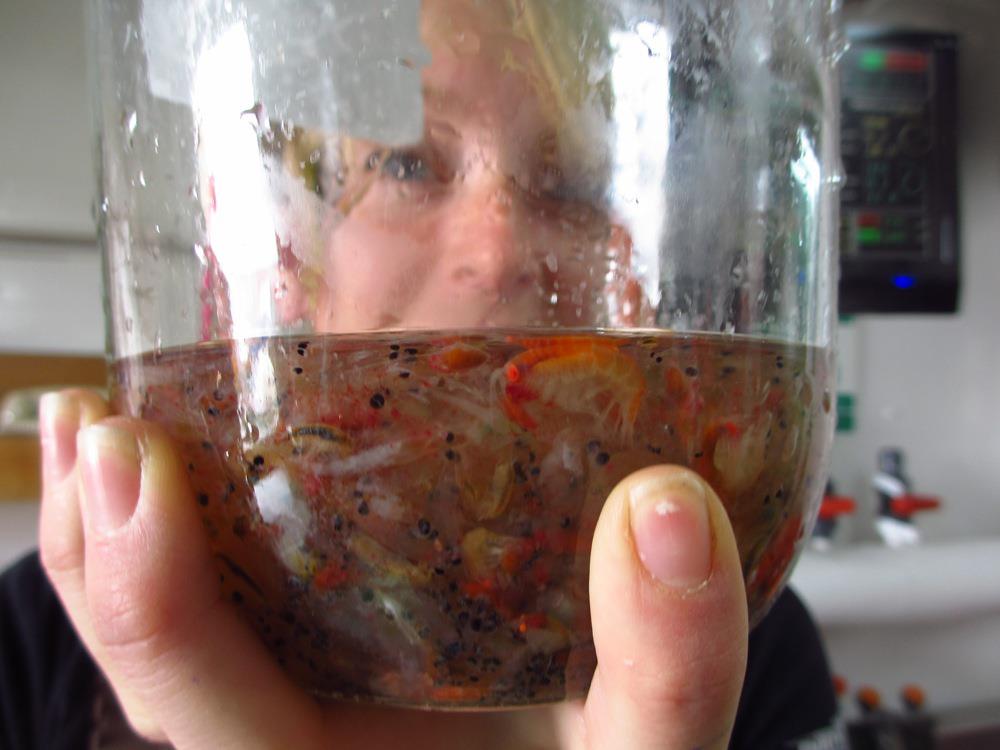ISB in Antarctica: A Glimpse in the Lab
 isbscience.org/news/2013/02/21/isb-in-antarctica-a-glimpse-in-the-lab/
isbscience.org/news/2013/02/21/isb-in-antarctica-a-glimpse-in-the-lab/

The plankton net that we tow behind the boat at less than 2 knots collects many creatures. Krill is one of the animals responsible for sustaining the base of the food web. Note some krill have black eyes and some have red eyes.
From Allison Lee, ISB research associate:
Some randoms from me…..
1. Last night a couple of us did the INSANITY workout in the gym. Try doing plyometrics on a rocking ship. Extra calories staying balanced!
2. Today I begin a 24 hour shift. Every 3 hours for 24 hours, I will be collecting sea water and measuring the algae SNOT (aka algae microgels). Mmmm.
3. We brought a couple espresso machines. Gotta have those cappuccinos!
4. Our chef is actually a professional chef and has owned 5 restaurants. We are spoiled.
5. Our fun before-bed routine is to sit in the sauna for 30 minutes then run outside on-deck in the -30 C air and stand there until we get cold then run back into the sauna. (Read related posts.)
Here’s a video from the ice breaker Nathaniel B. Palmer, of what it like to sail the Ross Sea and some time-lapse of the international group of scientists working in the lab. The video was produced by Cassandra Brooks, of Stanford University.

Some of the scientists on board are collecting the sea water and measuring the concentration of oxygen.

There are four “labs” on ship. They were all empty and we had to set up all of our own equipment and secure everything to the counter and lock all of the cabinets and drawers so that during high waves things don’t fly off.

Sending the sediment trap into the water. Dave is tethered to the ship in case a wave should come knock him off.

Every day, chief-scientist, Dennis Hansell, and the other co-scientists sit down with maps, weather charts, and ice charts to plot out where in the Ross Sea we would like to take samples from. We sketch out a rough idea, but this idea may get altered depending on ice cover (can’t access an ideal location) or weather (too stormy or windy to stay there to sample).

A close up of the top of the sediment trap. In 1985 a paper was published that used Life Savers (specifically cherry flavored) to hold this contraption together. The sediment trap sinks to 150 meters and in 1 hour, the cherry Life Saver dissolves. The rubber band snaps off and the plastic wrap comes off the top of the straws. The straws are then “open” and can let in seawater and any little organisms that might be falling from the surface layers of the sea (anything above 150 meters falls in).

This is a homemade sediment trap, constructed from a description published in a 1985 paper. Tubes of water float upright in the water column and collect particles falling from the surface. They are filled with sea water that has had even more salt added to it so they are more dense than the surrounding sea. Being more dense allows the contraption to stay upright. The cherry-flavored Life Savers dissolve after 1 hour and the rubber bands snap off allowing the plastic to come off the tops. Once the tops are “open,” particles fall in to the tubes. This contraption is moving with the current (there is a garbage pail acting like a “sail” to catch the current and move the sediment trap horizontally) and after a couple days we pull it back on the boat and see what has fallen in to the tubes!






